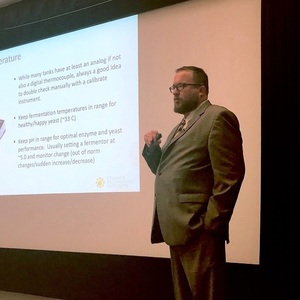Alcohol School: Keys to process monitoring

PHOTO: Lisa Gibson
September 11, 2019
BY Lisa Gibson
Consistent sampling is important in process monitoring, said Caleb Ogden, technical services manager for Lallemand Biofuels & Distilled Spirits, during Lallemand’s Alcohol School on Sept. 11. Communication between the sampler and analyzer is crucial, he said, as is processing that sample in a timely manner. Make sure the sample is a sufficient quantity and representative of the batch, too, he added.
Lallemand Biofuels & Distilled Spirits’ Alcohol School is being held Sept. 9-13 at Intercontinental Montreal in Montreal, Quebec. The sessions Sept. 11 were held at National Research Council Canada, with tours of Lallemand’s research lab spaces on site.
The five basic areas of the plant Ogden discussed are: grain receiving, milling, cooking/liquefaction, yeast and fermentation, and distillation/final product. In grain receiving, low-tech equipment options include grain sieve, and even visual indications. High-tech grain receiving equipment includes near infrared or moisture analysis, Ogden said. Don’t forget to clean bins, he told his audience.
Milling quality checks should employ consistent use of a sieve shaker, he said.
Advertisement
“There’s a lot to look at when it comes to the third section, liquefaction,” Ogden said. Plants will need to watch viscosity, density, pH, color, temperature, enzyme rates and odors. Density can be correlated to various percentages of solids measurements, he said. Viscosity can be visual, usually an indication of enzyme, but also can indicate an improper grain-to-water ratio.
“Yeast cell counts and health are extremely important to monitor,” Ogden said. Most plants are using high pressure liquid chromatography (HPLC) to monitor how much sugar is present, he said. A balling hydrometer also can be used. Ogden asked his audience if any fuel ethanol producers are not yet using an HPLC. No hands were raised.
Monitoring of yeast and bacteria can be done efficiently with microscopy, Ogden said. “You have real-time contamination tracking.” He also introduced other methods including dyes and bioluminescence.
Finally, in distillation, density can be determined with a hydrometer. More high-tech options exist but are not approved yet for fuel alcohol, Ogden said.
The future of lab instrumentation is products in portable formats, Ogden said. The disadvantage to portable products is they can be less accurate and might lack proper agency approval.
Advertisement
Ogden ended his presentation with a recommendation to calibrate regularly. Competent, passionate participants are needed in calibration, as well as adequate record keeping, he said.
“Calibration is critical,” he concluded. “Without it, your data is useless.”
Related Stories
The USDA’s Risk Management Agency is implementing multiple changes to the Camelina pilot insurance program for the 2026 and succeeding crop years. The changes will expand coverage options and provide greater flexibility for producers.
EcoCeres Inc. has signed a multi-year agreement to supply British Airways with sustainable aviation fuel (SAF). The fuel will be produced from 100% waste-based biomass feedstock, such as used cooking oil (UCO).
SAF Magazine and the Commercial Aviation Alternative Fuels Initiative announced the preliminary agenda for the North American SAF Conference and Expo, being held Sept. 22-24 at the Minneapolis Convention Center in Minneapolis, Minnesota.
Saipem has been awarded an EPC contract by Enilive for the expansion of the company’s biorefinery in Porto Marghera, near Venice. The project will boost total nameplate capacity and enable the production of SAF.
Global digital shipbuilder Incat Crowther announced on June 11 the company has been commissioned by Los Angeles operator Catalina Express to design a new low-emission, renewable diesel-powered passenger ferry.
Upcoming Events










